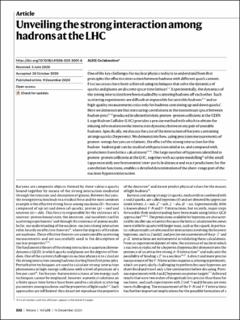Unveiling the strong interaction among hadrons at the LHC
Acharya, Shreyasi; Adamová, Dagmar; Adler, Alexander; Adolfsson, Jonatan; Aggarwal, Madan M.; Aglieri Rinella, Gianluca; Agnello, Michelangelo; Agrawal, Nikita; Ahammed, Zubayer; Ahmad, Shafiq F.; Alme, Johan; Altenkaemper, Lucas; Djuvsland, Øystein; Eikeland, Viljar Nilsen; Ersdal, Magnus Rentsch; Fionda, Fiorella Maria Celeste; Grøttvik, Ola Slettevoll; Lofnes, Ingrid Mckibben; Nystrand, Joakim; Rehman, Attiq Ur; Røhrich, Dieter; Tambave, Ganesh Jagannath; Ullaland, Kjetil; Wagner, Boris; Yang, Shiming; Yuan, Shiming; Zhou, Zhuo; Arsene, Ionut Cristian; Dordic, Olja; Lardeux, Antoine Xavier; Mahmood, Sohail Musa; Malik, Qasim Waheed; Neagu, Alexandra; Richter, Matthias; Røed, Ketil; Skaali, Toralf Bernhard; Tveter, Trine Spedstad; Wikne, Jon Christopher; Helstrup, Håvard; Hetland, Kristin Fanebust; Kileng, Bjarte; Nesbø, Simon Voigt; Storetvedt, Maksim Melnik; Langøy, Rune; Lien, Jørgen André; Ahn, Sang Un; Akbar, Zaenai; Akindinov, Alexander; Al-Turany, Mohammed; Alam, Sk Noor; ALICE, Collaboration
Peer reviewed, Journal article
Published version

Åpne
Permanent lenke
https://hdl.handle.net/11250/2729886Utgivelsesdato
2020Metadata
Vis full innførselSamlinger
Originalversjon
ALICE collaboration. (2020). Unveiling the strong interaction among hadrons at the LHC. Nature, 588(7837), 232-238. 10.1038/s41586-020-3001-6Sammendrag
One of the key challenges for nuclear physics today is to understand from first principles the effective interaction between hadrons with different quark content. First successes have been achieved using techniques that solve the dynamics of quarks and gluons on discrete space-time lattices1,2. Experimentally, the dynamics of the strong interaction have been studied by scattering hadrons off each other. Such scattering experiments are difficult or impossible for unstable hadrons3,4,5,6 and so high-quality measurements exist only for hadrons containing up and down quarks7. Here we demonstrate that measuring correlations in the momentum space between hadron pairs8,9,10,11,12 produced in ultrarelativistic proton–proton collisions at the CERN Large Hadron Collider (LHC) provides a precise method with which to obtain the missing information on the interaction dynamics between any pair of unstable hadrons. Specifically, we discuss the case of the interaction of baryons containing strange quarks (hyperons). We demonstrate how, using precision measurements of proton–omega baryon correlations, the effect of the strong interaction for this hadron–hadron pair can be studied with precision similar to, and compared with, predictions from lattice calculations13,14. The large number of hyperons identified in proton–proton collisions at the LHC, together with accurate modelling15 of the small (approximately one femtometre) inter-particle distance and exact predictions for the correlation functions, enables a detailed determination of the short-range part of the nucleon-hyperon interaction.
